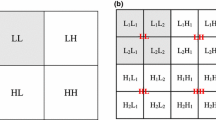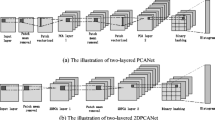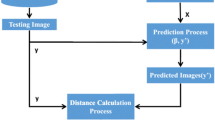Abstract
In this paper, an efficient approach is proposed for face recognition (FR) under pose and illumination variations. It is based on combining likelihood-based sufficient dimension reduction (LSDR) and linear discriminant analysis (LDA) using different facial features. LDA is a well–established technique for dimensionality reduction, while LSDR is a relatively new supervised subspace learning method based on the key concept of sufficiency, and consists of estimating a central subspace for low-dimensional representation of facial images. We show, empirically, that this combination can obviously increase the separability between face classes. The facial features that were considered here are either engineered (hand-crafted) features (e.g., discrete shearlet transform coefficients) or learned features which are obtained by retraining a deep learning-based system called FaceNet. To assess the performance of the proposed approach, different classification methods were used during the evaluation phase, namely collaborative representation based classifier (CRC), KNN, linear SVM and three regression-based classifiers (LSRC, LRC and LDRC). The extensive experiments performed on four publicly available face databases – the extended Yale B, FERET, LFW and CMU Multi-PIE– have demonstrated that, on the one hand, LSDR is an effective and efficiency dimensionality reduction technique for face recognition. Particularly, it can be used to significantly increase the performance of a deep learning-based system such as FaceNet, mainly, when training samples are insufficient. On the other hand, its combination with LDA can outperform best individual face recognition algorithm based on LSDR or LDA. Furthermore, the proposed approach compares favorably to current state-of-the-art methods on face recognition, in terms of classification accuracy, under illumination and pose variations.











Similar content being viewed by others
References
Abate AF, Nappi M, Riccio D, Sabatino G (2007) 2D and 3D face recognition: a survey. Pattern Recogn Lett 28(14):1885–1906
Adragni KP (2009) Dimension reduction and prediction in large p regressions. Phd Thesis, Graduate School of the University of Minnesota
Adragni KP, Cook RD (2009) Fisher lecture: dimension reduction in regression (with discussion). Philos Trans R Soc Lond A 367(1906):4385–4406
Baek J, Kim M (2004) Face recognition using partial least squares components. Pattern Recogn 37(6):1303–1306
Cai Y, Lei Y, Yang M, You Z, Shan S (2019) A fast and robust 3d face recognition approach based on deeply learned face representation. Neurocomputing 363:375–397
Cao F, Hu H, Lu J, Zhao J, Zhou Z, Wu J (2016) Pose and illumination variable face recognition via sparse representation and illumination dictionary. Knowl-Based Syst 107:117–128
Chatterjee S, Hadi AS (2012) Regression analysis by example (5th edition). Wiley
Chen Y, Su J (2017) Sparse embedded dictionary learning on face recognition. Pattern Recogn 64:51–59
Cook RD, Forzani L (2008) Principal fitted components for dimension reduction in regression. Stat Sci 23(4):485–501
Cook RD, Forzani LM, Tomassi DR (2011) LDR: a package for likelihood-based sufficient dimension reduction. J Stat Softw 39(3):1–20
Dalal N, Triggs B (2005) Histograms of oriented gradients for human detection. In: 2005 IEEE computer society conference on computer vision and pattern recognition (CVPR 2005), 20–26 June 2005, San Diego, CA, USA, pp 886–893
Deng J, Guo J, Zafeiriou S (2018) Arcface: additive angular margin loss for deep face recognition. arXiv:1801.07698
Ding C, Choi J, Tao D, Davis LS (2016) Multi-directional multi-level dual-cross patterns for robust face recognition. IEEE Trans Pattern Anal Mach Intell 38(3):518–531
Duda RO, Hart PE, Stork DG (2000) Pattern classification (2nd edition). Wiley-Interscience
Faraji MR, Qi X (2016) Face recognition under varying illuminations using logarithmic fractal dimension-based complete eight local directional patterns. Neurocomputing 199:16–30
Fukunaga K (1990) Introduction to statistical pattern recognition, 2nd edn. Academic Press Professional, San Diego
Gaidhane VH, Hote YV, Singh V (2014) An efficient approach for face recognition based on common eigenvalues. Pattern Recogn 47(5):1869–1879
Gerbrands JJ (1981) On the relationships between SVD, KLT and PCA. Pattern Recogn 14(1-6):375–381
Gilani SZ, Mian A (2017) Learning from millions of 3d scans for large-scale 3d face recognition. arXiv:1711.05942
Gross R, Matthews IA, Cohn JF, Kanade T, Baker S (2010) Multi-pie. Image Vision Comput 28(5):807–813
Guo G, Zhang N (2019) A survey on deep learning based face recognition. Comput Vis Image Underst, 189
He K, Zhang X, Ren S, Sun J (2016) Deep residual learning for image recognition. In: 2016 IEEE conference on computer vision and pattern recognition, CVPR 2016, Las Vegas, NV, USA, June 27–30, 2016, pp 770–778
Huang GB, Ramesh M, Berg T, Learned-Miller E (2007) Labeled faces in the wild: a database for studying face recognition in unconstrained environments. Technical Report 07-49, University of Massachusetts, Amherst
Huang S-M, Yang J-F (2013) Linear discriminant regression classification for face recognition. IEEE Signal Processing Letters 20(1):91–94
Huang K-K, Dai D-Q, Ren C-X, Yu Y-F, Lai Z-R (2017) Fusing landmark-based features at kernel level for face recognition. Pattern Recogn 63:406–415
James EAK, Annadurai S (2011) An efficient Bayesian approach to face recognition based on wavelet transform. Int J Comput Appl 15(8):22–26
Jayaraman U, Gupta P, Gupta S, Arora G, Tiwari K (September 2020) Recent development in face recognition. Neurocomputing 408:231–245. https://doi.org/10.1016/j.neucom.2019.08.110. Elsevier BV
Jiang B, Mandal XD, Kot A (2008) Eigenfeature regularization and extraction in face recognition. IEEE Trans Pattern Anal Mach Intell 30(3):383–394
Jolliffe IT (2002) Principal component analysis. Springer series in statistic, 2nd edn. Springer, New York
Kim KI, Jung K, Kim HJ (2002) Face recognition using kernel principal component analysis. IEEE Signal Processing Letters 9(2):40–42
Kim H-C, Kim D, Bang SY (2003) Face recognition using LDA mixture model. Pattern Recogn Lett 24(15):2815–1821
Krizhevsky A, Sutskever I, Hinton GE (2012) Imagenet classification with deep convolutional neural networks. In: Advances in neural information processing systems 25: 26th annual conference on neural information processing systems 2012. Proceedings of a meeting held December 3–6, 2012, Lake Tahoe, Nevada, United States, pp 106–1114
Kutyniok G, Labate D (2012) Shearlets: multiscale analysis for multivariate data. Basel, Birkhäuser
Lee K-C, Ho J, Kriegman DJ (2005) Acquiring linear subspaces for face recognition under variable lighting. IEEE Trans Pattern Anal Mach Intell 27(5):684–698
Li H, Suen CYY (2016) Robust face recognition based on dynamic rank representation. Pattern Recogn 60:13–24
Li M, Yuan B (2005) 2D-LDA: a statistical linear discriminant analysis for image matrix. Pattern Recogn Lett 26(5):527–532
Li A, Shan S, Chen X, Gao W (2011) Cross-pose face recognition based on partial least squares. Pattern Recogn Lett 32(15):1948–1955
Li H, Shen F, Shen C, Yang Y, Gao Y (2016) Face recognition using linear representation ensembles. Pattern Recogn 59:72–87
Lin M, Chen Q, Yan S (2013) Network in network. arXiv:1511.02683
Liu C, Wechsler H (2000) Robust coding schemes for indexing and retrieval from large face databases. IEEE Trans Image Process 9(1):132–137
Liu C, Wechsler H (2003) Independent component analysis of Gabor features for face recognition. IEEE Trans Neural Netw 14(4):919–928
Liu Q, Lu H, Ma S (2004) Improving kernel fisher discriminant analysis for face recognition. IEEE Transactions on Circuits and Systems for Video Technology 14(1):42–49
Liu W, Wen Y, Yu Z, Li M, Raj B, Song L (2017) Sphereface: deep hypersphere embedding for face recognition. In: 2017 IEEE conference on computer vision and pattern recognition, CVPR 2017, Honolulu, HI, USA, July 21–26, 2017, pp 6738–6746
Liu Y, Li H, Wang X (2017) Rethinking feature discrimination and polymerization for large-scale recognition. arXiv:1710.00870v2
Liu W, Lin R, Liu Z, Liu L, Yu Z, Dai B, Song L (2018) Learning towards minimum hyperspherical energy. In: Advances in neural information processing systems 31: annual conference on neural information processing systems 2018, neurIPS 2018, 3–8 December 2018, Montréal, Canada, pp 6225–6236
Martínez A M, Kak AC (2001) PCA versus LDA. IEEE Trans Pattern Anal Mach Intell 23(2):228–233
Mashhoori A, Jahromi MZ (2007) Block-wise two-directional 2DPCA with ensemble learning for face recognition. Neurocomputing 108:111–117
Naseem I, Togneri R, Bennamoun M (2010) Linear regression for face recognition. IEEE Trans Pattern Anal Mach Intell 32(11):2106–2112
Noushath S, Kumar GH, Shivakumara P (2006) (2D)2LDA: an efficient approach for face recognition. Pattern Recogn 39(7):1396–1400
Ojala T, Pietikäinen M, Mäenpää T (2002) Multiresolution gray-scale and rotation invariant texture classification with local binary patterns. IEEE Trans Pattern Anal Mach Intell 24(7):971–987
Parkhi OM, Vedaldi A, Zisserman A (2015) Deep face recognition. In: Proceedings of the british machine vision conference 2015, BMVC 2015, Swansea, UK, September 7–10, 2015, pp 41.1–41.12
Pei T, Zhang L, Wang B, Li F, Zhang Z (2017) Decision pyramid classifier for face recognition under complex variations using single sample per person. Pattern Recogn 64:305–313
Phillips PJ, Wechsler H, Huang J, Rauss PJ (1998) The FERET database and evaluation procedure for face-recognition algorithms. Image Vis Comput 16(5):295–306
Ranjan R, Sankaranarayanan S, Bansal A, Bodla N, Chen J-C, Patel VM, Castillo CD, Chellappa R (2018) Deep learning for understanding faces: machines may be just as good, or better, than humans. IEEE Signal Process Mag 35(1):66–83
Ren C-X, Lei Z, Dai D-Q, Li SZ (2016) Enhanced local gradient order features and discriminant analysis for face recognition. IEEE Transactions on Cybernetics 46(11):2656–2669
Schmidhuber J (2015) Deep learning in neural networks: an overview. Neural Netw 61:85–117
Schölkopf B, Smola AJ (2002) Learning with kernels: support vector machines, regularization, optimization, and beyon. The MIT Press
Schroff F, Kalenichenko D, Philbin J (2015) FaceNet: a unified embedding for face recognition and clustering. In: Proceedings of the 2015 IEEE conference on computer vision and pattern recognition (CVPR 2015), CVPR 2015, Boston, MA, USA, pp 815–823
Shekar BH, Kumari MS, Mestetskiy LM, Dyshkant NF (2011) Face recognition using kernel entropy component analysis. Neurocomputing 74 (6):1053–1057
Shepley AJ (2019) Deep learning for face recognition: a critical analysis. arXiv:1907.12739
Simonyan K, Zisserman A (2014) Very deep convolutional networks for large-scale image recognition. arXiv:1511.02683
Sirovich L, Kirby M (1987) Low-dimensional procedure for the characterization of human faces. J Opt Soc Am A 4(3):519–524
Song F, Zhang D, Wang J, Liu H, Tao Q (2007) A parameterized direct LDA and its application to face recognition. Neurocomputing 71 (1-3):191–196
Steidl G, Häuser S (2014) Fast finite shearlet transform: a tutorial. arXiv:1202.1773
Sun Y, Chen Y, Wang X, Tang X (2014) Deep learning face representation by joint identification-verification. In: Advances in neural information processing systems 27: annual conference on neural information processing systems 2014, December 8–13 2014, Montreal, Quebec, Canada, pp 1988–1996
Sun Y, Wang X, Tang X (2014) Deep learning face representation from predicting 10, 000 classes. In: 2014 IEEE conference on computer vision and pattern recognition. IEEE
Sun Y, Wang X, Tang X (2015) Deeply learned face representations are sparse, selective, and robust. In: IEEE conference on computer vision and pattern recognition, CVPR 2015, Boston, MA, USA, June 7–12, 2015, pp 2892–2900
Szegedy C, Liu W, Jia Y, Sermanet P, Reed SE, Anguelov D, Erhan D, Vanhoucke V, Rabinovich A (2015) Going deeper with convolutions. In: IEEE conference on computer vision and pattern recognition, CVPR 2015, Boston, MA, USA, June 7–12, 2015, pp 1–9
Szegedy C, Ioffe S, Vanhoucke V, Alemi AA (2017) Inception-v4, inception-ResNet and the impact of residual connections on learning. In: Proceedings of the thirty-first AAAI conference on artificial intelligence, February 4–9, 2017, San Francisco, California, USA, pp 4278–4284
Turk M, Pentland A (1991) Eigenfaces for recognition. J Cogn Neurosci 3(1):71–86
Viola P, Jones MJ (2004) Robust real-time face detection. Int J Comput Vis 57(2):137–154
Wang M, Deng W (2018) Deep visual domain adaptation: a survey. arXiv:1802.03601
Wang Q, Guo G (2019) Benchmarking deep learning techniques for face recognition. J Vis Commun Image Represent 65:102663
Weinberger KQ, Blitzer J, Saul LK (2005) Distance metric learning for large margin nearest neighbor classification. In: Advances in neural information processing systems 18 [neural information processing systems, NIPS 2005, December 5–8, 2005, Vancouver, British Columbia, Canada], pp 1473–1480
Wen Y (2012) An improved discriminative common vectors and support vector machine based face recognition approach. Expert Syst Appl 39(4):4628–4632
William I, Setiadi DRIM, Rachmawanto EH, Santoso HA, Sari CA (2019) Face recognition using FaceNet (survey, performance test, and comparison). In: 2019 fourth international conference on informatics and computing (ICIC). IEEE
Wright J, Yang AY, Ganesh A, Sastry SS, Ma Y (2009) Robust face recognition via sparse representation. IEEE Trans Pattern Anal Mach Intell 31(2):210–227
Wu X, He R, Sun AZ (2015) A lightened cnn for deep face representation with noisy labels. arXiv:1511.02683
Wu X, Li Q, Xu L, Chen K, Yao L (2017) Multi-feature kernel discriminant dictionary learning for face recognition. Pattern Recogn 66:404–411
Wu X, Sahoo D, Hoi SCH (2020) Recent advances in deep learning for object detection. Neurocomputing 396:39–64
Yang M-H (2002) Kernel eigenfaces vs. kernel fisherfaces: face recognition using kernel methods. In: 5th IEEE international conference on automatic face and gesture recognition, pp 215–220
Yang W-H, Dai D-Q (2009) Two-dimensional maximum margin feature extraction for face recognition. IEEE Trans Syst Man Cybern B 39(4):1002–1012
Yang J, Zhang D (2004) Two-dimensional PCA: a new approach to appearance-based face representation and recognition. IEEE Trans Pattern Anal Mach Intell 26(1):131–137
Yaniv T, Yang M, Ranzato MA, Wolf L (2014) Deepface: closing the gap to human-level performance in face verification. In: 2014 IEEE conference on computer vision and pattern recognition. IEEE
Yi S, Ding L, Xiaogang W, Xiaoou T (2015) Deepid3: face recognition with very deep neural networks. arXiv:1502.00873
You M, Han X, Xu Y, Li L (2020) Systematic evaluation of deep face recognition methods. Neurocomputing 388:144–156
Zeiler MD, Fergus R (2014) Visualizing and understanding convolutional networks. In: Computer vision - ECCV 2014 - 13th European conference, Zurich, Switzerland, September 6–12, 2014, proceedings, Part I, pp 818–833
Zhang L, M Y, Feng X (2011) Sparse representation or collaborative representation: Which helps face recognition?. In: 2011 international conference on computer vision, pp 471–478
Zhang H, Wu QMJ, Chow TWS, Zhao M (2012) A two-dimensional neighborhood preserving projection for appearance-based face recognition. Pattern Recogn 45(5):1866–1876
Zhang K, Zhang Z, Li Z, Qiao Y (2016) Joint face detection and alignment using multitask cascaded convolutional networks. IEEE Signal Process Lett 23(10):1499–1503
Zhang G, Sun H, Ji Z, Yuan Y, Sun Q-S (2016) Cost-sensitive dictionary learning for face recognition. Pattern Recogn 60:613–629
Zhao Z-Q, Cheung YM, Hu H, Wu X (2016) Corrupted and occluded face recognition via cooperative sparse representation. Pattern Recogn 56:77–87
Zheng W-S, Lai JH, Li SZ (2008) 1D-LDA vs. 2D-LDA: when is vector-based linear discriminant analysis better than matrix-based? Pattern Recogn 41 (7):2156–2172
Zheng X, Guo Y, Huang H, Li Y, He R (March 2020) A survey of deep facial attribute analysis. Int J Comput Vis 128(8-9):2002–2034. https://doi.org/10.1007/s11263-020-01308-z
Zuo W, Zhang D, Yang J, Wang K (2006) BDPCA plus LDA: a novel fast feature extraction technique for face recognition. IEEE Trans Syst Man Cybern B Cybern 36(4):946–953
Author information
Authors and Affiliations
Corresponding author
Additional information
Publisher’s note
Springer Nature remains neutral with regard to jurisdictional claims in published maps and institutional affiliations.
Rights and permissions
About this article
Cite this article
Benouareth, A. An efficient face recognition approach combining likelihood-based sufficient dimension reduction and LDA. Multimed Tools Appl 80, 1457–1486 (2021). https://doi.org/10.1007/s11042-020-09527-9
Received:
Revised:
Accepted:
Published:
Issue Date:
DOI: https://doi.org/10.1007/s11042-020-09527-9




